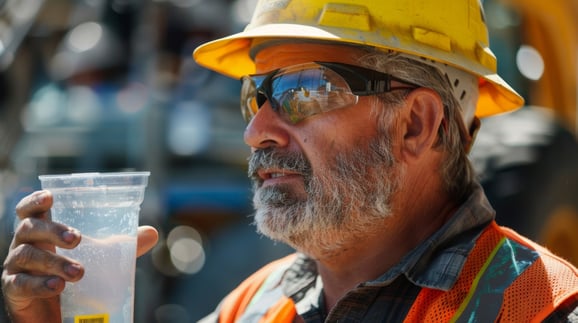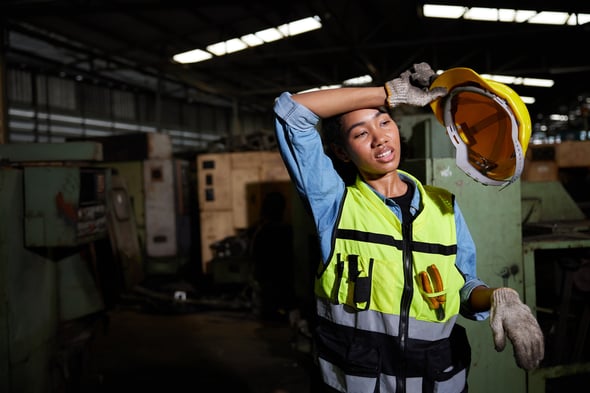The heat of summer can throw a curveball at businesses when it comes to employee health and safety. Most companies can anticipate the typical temperature changes throughout the year. But what about intense heatwaves that cause above-average temperatures?
In cases of extreme temperatures, special accommodations and actions must be made to protect workers. Here are some steps that companies can ensure a safe working environment during summer heatwaves.
Assess the Danger
The first step in enhancing worker safety is always to assess the danger. When it comes to heat waves, this means assessing how much working in the heat is a concern. This depends on a variety of factors. First, are employees working outside, inside, or a combination of the two? Second, do some employees have jobs that are more strenuous or require a lot of protective equipment that will make them feel hotter than those wearing lightweight clothing?
Also, individual workers may respond differently to extreme heat. Older employees may struggle to work in the heat, as will those who may have certain pre-existing health conditions. It’s important to look at every individual employee and assess how much they could potentially struggle if asked to perform their job in extreme heat. From there, it’s possible to start making alterations to work patterns that can help alleviate the safety risk of working in extreme conditions.
Plan Ahead
Planning ahead is also key to keeping employees safe. Don’t allow a heatwave to sneak up on you. Company leaders should be monitoring the weather days in advance or know ahead of time what days will be the hottest and create the most challenges. Likewise, being prepared means being proactive with what kind of changes will be warranted based on the expected temperatures. Don’t allow employees to start suffering distress from the heat before doing something about it. Instead, businesses should start making arrangements before the heat gets bad.
Have Emergency Supplies
This is another way of planning ahead. Company leaders need to know how to respond if an employee starts experiencing a heat-related illness and have the supplies to properly help them. This means having clean drinking water and beverages with electrolytes readily available. Ideally, there should be one gallon of drinking water available for every person in the workplace. Being ready also means having cold compresses that can be used to cool someone down quickly. Naturally, a standard first-aid kit should also be on hand to deal with the minor injuries that could occur.
Stay Hydrated
Naturally, encouraging employees to stay hydrated is the best thing a business can do to protect workers from a heatwave. Actually, demanding that they stay hydrated is the best thing they can do. Ordinarily, a person should drink about three-quarters of a gallon of water every day. That amount may need to be increased during a heat wave.
Employers need to give workers an adequate amount of hydration breaks so that they can drink water and eat small meals to help them keep up their strength. During a heatwave, it’s vital for employees to avoid drinks that are high in sugar and caffeine. Instead, they should drink water or drinks that have electrolytes in order to stay hydrated.
Dress Appropriately
Businesses should also emphasize to employees the need to dress for the heat. Wearing light and loose-fitting clothing is always best for hot conditions. If needed, businesses should relax any restrictions they have for uniforms during a heatwave if those uniforms aren’t made of light fabric and light colors. If protective equipment that’s heavy and increases the burden on employees in hot conditions is unavoidable, other alterations to someone’s work schedule or duties may need to be made to compensate and reduce their work-related stress.
Ramp Up Slowly
In hot conditions, employees need to be taught to take things slowly compared to a normal day at work. This is particularly important for anyone performing physical labor during a heatwave. The body needs time to adjust to working in such hot conditions. In fact, once the weather starts to heat up in the spring and summer, workers need to reduce their workload and slowly ramp up to a normal workload over a week or two.
Employers can’t expect the same productivity from workers in extreme conditions. Forcing them to match their normal productivity will put them at great risk of heat-related illnesses. Instead, employees should be encouraged to slow down and only gradually increase their workload day by day when the weather heats up during the summer.
Increase Break Frequency
In addition to workers being allowed to pace themselves and ramp up slowly, taking frequent breaks is another necessary ingredient for employee safety during a heatwave. While laboring in extreme heat, the body needs more frequent rest. The limits to what the body can do without great distress are reduced. If employees have a normal break schedule, additional breaks need to be added if they are working outside in extreme heat.

Create Cool-Down Areas
Ideally, employers will be able to establish cool-down areas where employees can go during their breaks. A cool-down area should be in the shade or under a tent; anywhere employees aren’t standing directly under the sun. There should be fans or some other cooling mechanism in this area that allows air to circulate and can help employees feel cooler while taking their break. If employees are forced to wear heavy equipment to do their jobs, allow them to take off that equipment while taking breaks in cool-down areas; otherwise, the benefits of these areas won’t be as great.
Cool Down Proactively
Scheduling breaks and trips to cool-down areas is essential for employees working in extreme heat. These types of precautions should be proactive rather than waiting for employees to start feeling the effects of the heat. By the time someone starts to feel heat-related illness, it might be too late to reverse the effects. Instead, use scheduled breaks to allow employees to put ice packs of cold washcloths on their bodies to keep their body temperatures from climbing too high. Being proactive like this is the best way to prevent heat-related illnesses, which is always better than trying to treat them.
Provide Training and Preparation
Naturally, it’s critical to train employees on how to work differently in extreme heat so that they are fully prepared whenever a heatwave strikes. This means instructing them on how frequently they should take breaks, how they should dress, and how to alter their work habits. They need to know how to stay hydrated, how to cool down their body temperature, and how to recover after working in extreme heat. Even if some of these measures seem simple and obvious, employers still need to explain them in detail and take no chances that employees have the information they need to work safely in hot conditions.
Use the Right Tools
No employer should be overlooking the importance of technological tools that can help them keep employees safe during heat waves. For example, EHS Insight has a Weather Integration dashboard on its workplace safety system. This tool can provide a 5-day forecast and deliver weather alerts based on certain temperatures or heat index. Therefore, companies can be aware that extreme heat is on the way and start making preparations and adjustments before the heat wave arrives. This is just one reason why the EHS Insight dashboard is a great tool for employee safety.
Monitor for Signs of Heat Illness
Just in case preparation isn’t enough, it’s vital for all employees and supervisors to know the signs of heat illness. Since employees can’t consistently monitor their body temperature, everyone should be looking out for everyone else and be aware of the symptoms that signal that someone could be in trouble.
In fact, it might be best to utilize the buddy system so that employees can monitor each other for signs of heat exhaustion. Employees are more likely to notice sluggishness or other signs of impairment in someone else before they recognize heat-related symptoms in themselves. The last thing any employee wants is someone suffering heat stroke, which can potentially cause someone to lose consciousness. Just like other aspects of employee safety, everyone needs to be involved in protecting one another.

Have a Heat Illness Response
Of course, prevention against heat-related illnesses is always the goal, but knowing how to treat them is just as important. Employees should be trained on what to do if they recognize that somebody could be in trouble. They need to know to get them to a shaded area and provide them with cold water to drink and an ice bath or cold washcloths that can cool them down quickly.
Performing basic first aid or even CPR might be necessary too if the symptoms of heat stroke are bad enough. Hopefully, it never comes to that, but anything is possible when employees are working under extreme heat. That’s why employers need to be proactive in keeping employees protected but also prepared for the worst-case scenario.

